| dc.contributor.author | Krams, Indrikis A. | |
| dc.contributor.author | Mennerat, Adele | |
| dc.contributor.author | Krama, Tatjana | |
| dc.contributor.author | Krams, Ronalds | |
| dc.contributor.author | Joers, Priit | |
| dc.contributor.author | Elferts, Didzis | |
| dc.contributor.author | Luoto, Severi | |
| dc.contributor.author | Rantala, Markus J. | |
| dc.contributor.author | Eliassen, Sigrunn | |
| dc.date.accessioned | 2022-12-14T10:56:33Z | |
| dc.date.available | 2022-12-14T10:56:33Z | |
| dc.date.created | 2022-05-12T12:38:05Z | |
| dc.date.issued | 2022 | |
| dc.identifier.issn | 0027-8424 | |
| dc.identifier.uri | https://hdl.handle.net/11250/3037665 | |
| dc.description.abstract | In many social animals, females mate with multiple males, but the adaptive value of female extra-pair mating is not fully understood. Here, we tested whether male pied flycatchers (Ficedula hypoleuca) engaging in extra-pair copulations with neighboring females were more likely to assist their neighbors in antipredator defense. We found that extra-pair sires joined predator-mobbing more often, approached predators more closely, and attacked predators more aggressively than males without extra-pair offspring in the neighboring nest. Extra-pair mating may incentivize males to assist in nest defense because of the benefits that this cooperative behavior has on their total offspring production. For females, this mating strategy may help recruit more males to join in antipredator defense, offering better protection and ultimately improving reproductive success. Our results suggest a simple mechanism by which extra-pair mating can improve reproductive success in breeding birds. In summary, males siring extra-pair offspring in neighboring nests assist neighbors in antipredator defense more often than males without extra-pair offspring. | en_US |
| dc.language.iso | eng | en_US |
| dc.publisher | National Academy of Sciences of the United States of America | en_US |
| dc.rights | Attribution-NonCommercial-NoDerivatives 4.0 Internasjonal | * |
| dc.rights.uri | http://creativecommons.org/licenses/by-nc-nd/4.0/deed.no | * |
| dc.title | Extra-pair paternity explains cooperation in a bird species | en_US |
| dc.type | Journal article | en_US |
| dc.type | Peer reviewed | en_US |
| dc.description.version | publishedVersion | en_US |
| dc.source.articlenumber | e2112004119 | en_US |
| cristin.ispublished | true | |
| cristin.fulltext | original | |
| cristin.qualitycode | 2 | |
| dc.identifier.doi | 10.1073/pnas.2112004119 | |
| dc.identifier.cristin | 2023886 | |
| dc.source.journal | Proceedings of the National Academy of Sciences of the United States of America (PNAS) | en_US |
| dc.identifier.citation | Proceedings of the National Academy of Sciences of the United States of America (PNAS). 2022, 119 (5), e2112004119. | en_US |
| dc.source.volume | 119 | en_US |
| dc.source.issue | 5 | en_US |

